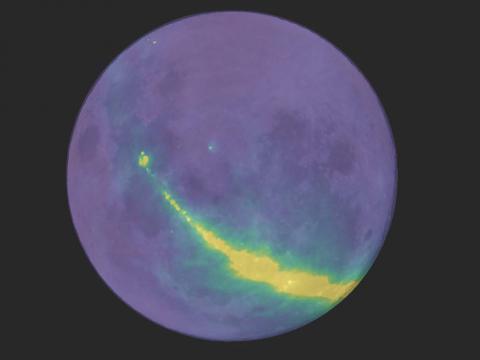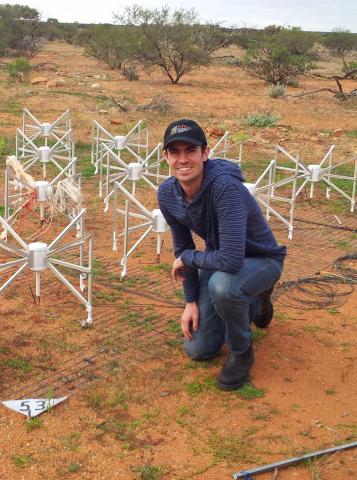The Moon may be the key to unlocking how the first stars and galaxies shaped the early Universe. A team of astronomers led by Dr Benjamin McKinley observed the Moon with a radio telescope to help search for the faint signal from hydrogen atoms, in research published today in the journal Monthly Notices of the Royal Astronomical Society.
“Before there were stars and galaxies, the Universe was pretty much just hydrogen, floating around in space,” said Dr McKinley, an astronomer at Curtin University - node of the International Centre for Radio Astronomy Research (ICRAR) - and the ARC Centre of Excellence for All Sky Astrophysics in 3 Dimensions (ASTRO 3D).
“Since there are no sources of the optical light visible to our eyes, this early stage of the Universe is known as the ‘cosmic dark ages’”.
The astronomers describe how they have used the Murchison Widefield Array (MWA) radio telescope to help search for radio signals given off by the hydrogen atoms. “The MWA takes the radio signals from space and we can then convert them into images of the sky,” explains Dr McKinley.
This radio signal from the early Universe is very weak compared to the extremely bright objects in the foreground, which include accreting black holes in other galaxies and electrons in our own Milky Way.

The key to solving this problem is being able to precisely measure the average brightness of the sky. However, built-in effects from the instruments and radio frequency interference make it difficult to get accurate observations of this very faint radio signal.
In this work, the astronomers used the Moon as a reference point of known brightness and shape. This allowed the team to measure the brightness of the Milky Way at the position of the occulting Moon.
The astronomers also took into account ‘earthshine’—radio waves from Earth that reflect off the Moon and back onto the telescope. Earthshine corrupts the signal from the Moon and the team had to remove this contamination from their analysis.
“If we can detect this radio signal it will tell us whether our theories about the evolution of the Universe are correct,” added Dr McKinley.
With more observations, the astronomers hope to uncover the hydrogen signal and put theoretical models of the Universe to the test.
Media contacts
Ingrid McCarthy
ASTRO 3D
Tel: +61 407 070 769
Lucien Wilkinson
Curtin University
Tel: +61 401 103 683
lucien.wilkinson@curtin.edu.au
Robert Massey
Royal Astronomical Society
Mob: +44 (0)7802 877 699
Morgan Hollis
Royal Astronomical Society
Tel: +44 (0)20 7292 3977 x118
Mob: +44 (0)7802 877 700
Science contacts
Dr Benjamin McKinley
ICRAR / Curtin University
Images and captions


Further information
The new work appears in: “Measuring the global 21-cm signal with the MWA-I: improved measurements of the Galactic synchrotron background using lunar occultation”, B. McKinley, G. Bernardi, C.M. Trott, et al., Monthly Notices of the Royal Astronomical Society (2018), in press (DOI: 10.1093/mnras/sty2437).
A copy of the paper is available from: https://doi.org/10.1093/mnras/sty2437
Notes for editors
The Royal Astronomical Society (RAS, www.ras.ac.uk), founded in 1820, encourages and promotes the study of astronomy, solar-system science, geophysics and closely related branches of science. The RAS organizes scientific meetings, publishes international research and review journals, recognizes outstanding achievements by the award of medals and prizes, maintains an extensive library, supports education through grants and outreach activities and represents UK astronomy nationally and internationally. Its more than 4,000 members (Fellows), a third based overseas, include scientific researchers in universities, observatories and laboratories as well as historians of astronomy and others.
The RAS accepts papers for its journals based on the principle of peer review, in which fellow experts on the editorial boards accept the paper as worth considering. The Society issues press releases based on a similar principle, but the organisations and scientists concerned have overall responsibility for their content.
Twitter: https://twitter.com/royalastrosoc
Facebook: https://facebook.com/royalastrosoc
Instagram: https://www.instagram.com/royalastrosoc/
YouTube: https://www.youtube.com/user/RoyalAstroSoc/feed
ASTRO 3D is the ARC Centre of Excellence for All Sky Astrophysics in 3 Dimensions. It is a collaborative research organisation of six Australian Universities (the Australian National University, Curtin University, the University of Western Australia, Swinburne University of Technology, The University of Melbourne and the University of Sydney) and Australian and international partner institutions.
The Murchison Widefield Array (MWA) is a low frequency radio telescope and is the first of four Square Kilometre Array (SKA) precursors to be completed.
A consortium of 21 partner institutions from six countries (Australia, USA, New Zealand, Canada, Japan, and China) currently finance the development, construction, commissioning, and operations of the facility. The MWA consortium is led by Curtin University.
The International Centre for Radio Astronomy Research (ICRAR) is a joint venture between Curtin University and The University of Western Australia with support and funding from the State Government of Western Australia.

